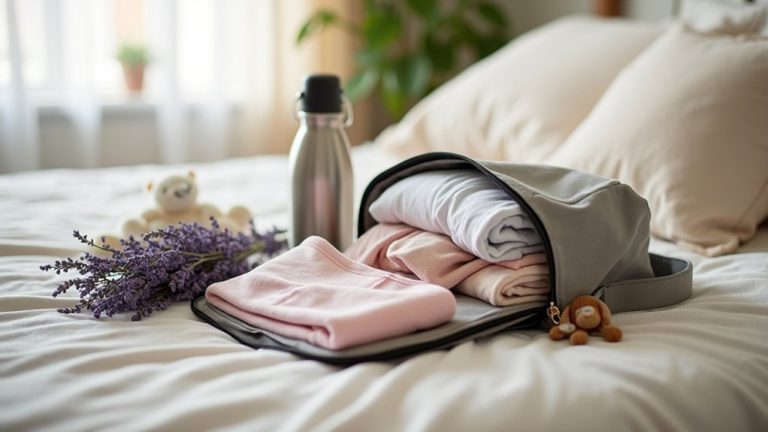Start by assembling the crib, ensuring its command center status with tight screws. Position it safely away from windows, curtains, and cords. Optimize storage using labeled bins and secure heavy furniture with anchors. Deploy dimmable LEDs for perfect lighting and cover outlets for electrical safety. Delight in multitasking with a smart thermostat to regulate nursery climate like a pro. Childproof corners and test baby monitors for seamless communication. Reveal more insights as you progress.
Key Points
- Assemble and position the crib securely, away from windows and cords, ensuring mattress snugness for safety and airflow.
- Anchor heavy furniture to walls and use anti-tip kits to prevent accidental tipping over.
- Install dimmable LEDs and a smart thermostat for optimal lighting and temperature control.
- Deploy outlet covers, cabinet locks, and cushioned guards to childproof the nursery environment effectively.
- Regularly check and maintain the nursery setup to ensure ongoing safety and efficiency.
Assembling and Positioning the Crib

Before you delve into the world of sleepless nights and diaper duty, it’s vital to master the art of crib assembly and positioning—think of it as your first deployment in DadOps. Begin your nursery setup by consulting the babyproofing checklist.
Assemble the crib with precision; it’s your baby’s initial command center. Position the crib away from windows, curtains, and cords—safety first! Confirm the mattress fits snugly, eliminating potential hazards. Consider airflow and temperature: a well-ventilated spot is essential. Double-check screws and bolts, making sure they’re tight. When choosing a baby carrier, prioritize comfort and safety to complement your nursery setup. Efficient diaper storage solutions are also crucial in maintaining an organized nursery, preventing clutter and ensuring easy access during diaper changes. To further enhance your nursery, explore the various options in baby bottle warmers, which offer convenience and safety for feeding routines.
Congratulations! You’re getting ready for baby, one strategic move at a time.
Installing the Changing Station

Having navigated the crib assembly like a pro, you’re ready to tackle the next mission in DadOps—installing the changing station. First, identify a stable, accessible surface. Think of it as the command center for diaper operations. Attach the safety strap securely to prevent unexpected rollouts—like a seatbelt for tiny astronauts. Keep in mind the importance of securing furniture to prevent tipping accidents, enhancing the safety of the nursery environment. To ensure a safe environment for children, conduct regular checks and adjustments as your child grows and becomes more mobile.
Position your diaper disposal unit within arm’s reach, ensuring efficient waste management. Arrange essential supplies: diapers, wipes, creams, in a logical sequence. Optimize the layout for speed and efficiency, because every second counts in the field.
To further enhance your nursery setup, consider adding a humidifier to maintain optimal humidity levels for your baby’s health and comfort.
Congratulations, you’ve transformed chaos into an orderly, tactical advantage.
Setting Up the Nursery Storage

Once you’ve secured the command center, it’s time to optimize the nursery storage like a seasoned pro. Prioritize accessibility—keep frequently used items within arm’s reach, minimizing potential chaos during a midnight mission. Use labeled bins and baskets for swift identification and retrieval. Install wall-mounted shelves to maximize vertical space; they’re your best allies in this operation. Secure bookcases to walls using anchor kits—gravity’s no friend here. Consider multi-drawer units for neatly stashing smaller gear. Remember, clear storage boxes offer efficient visual reconnaissance. By focusing on quality and functionality over quantity, you can ensure that your nursery storage is both practical and efficient. It’s also crucial to understand the importance of burping your infant after feeding to prevent discomfort and ensure a healthy feeding routine. Just as in optimizing hair and nail health, understanding the biological processes of your infant’s needs can significantly enhance their care and comfort.
Organizing Baby Clothes and Essentials

Now that your nursery storage is a model of operational efficiency, it’s time to tackle the next mission: organizing baby clothes and essentials. You need precision and strategic placement.
First, categorize your inventory. Sort by size, season, and frequency of use. Consider how GPU innovations have improved computational efficiency, which might inspire a more efficient way to organize your space.
Next, deploy drawer dividers and hangers for a streamlined system. Consider the importance of materials when selecting hangers to ensure they are safe and gentle on the baby’s delicate clothing.
Finally, optimize accessibility. Place daily-use items within easy reach and backup supplies in reserve areas.
- Sort and conquer: Divide clothes by size and season—future-proofing your operation.
- Deploy dividers: Use drawer organizers to avoid chaos.
- Strategic placement: Keep essentials within arm’s reach—no need for late-night treasure hunts.
Additionally, while organizing, consider how you can foster a sense of inclusion by involving your toddler in simple tasks like sorting clothes, which can help them feel connected to the upcoming changes.
Optimizing Lighting and Climate Control

Before you plunge into the tactical zone of lighting and climate control, remember this: the nursery is your production environment, not a nightclub.
Start with lighting. Install dimmable LEDs for gentle progressions from feeding to naptime, avoiding a disco vibe. Consider utilizing advanced machine learning algorithms to optimize the lighting adjustments automatically based on the time of day and baby’s sleep patterns. Using innovative approaches similar to those in lung branching simulations can help enhance the automated adjustments for optimal lighting.
Next, tackle climate. Set up a smart thermostat to maintain a steady, comfortable temperature. Aim for a cozy 68-72°F.
Add blackout curtains to manage natural light and temperature fluctuations.
Invest in a quiet, efficient fan for airflow.
Avoid overcomplicating—you’re not launching a rocket, just creating a serene space. Creating a safe sleep environment also involves making sure the sleep area is free from toys and other objects to reduce potential hazards.
Ensuring Electrical Safety

How do you guarantee your nursery doesn’t double as a mini electrical hazard zone? Start by viewing it like a server room: neat, organized, and secure.
Begin your audit with these tasks:
- Install outlet covers: Prevent tiny fingers from entering sockets; think of them as firewalls against unwanted access.
- Manage cords: Use cord shorteners or winders to prevent tangles; it’s like cable management but for a mini IT department.
- Secure power strips: Mount them out of reach; they’re not toys, even if they light up like a Christmas tree.
Building a solid foundation in your nursery setup is akin to establishing the groundwork for a successful project; both require careful planning and attention to detail. Just as bonding protocols enhance connectivity in networked systems, ensuring a secure nursery environment enhances the safety and well-being of your child.
To ensure your nursery remains safe and efficient, ongoing monitoring is crucial, much like maintaining a robust and efficient tech system to prevent disruptions.
Follow these steps, and your nursery will run as smoothly as your favorite tech gadget.
Securing Furniture and Heavy Items

Although setting up your nursery might feel like a formidable project, begin by thinking of it as a server room that needs optimization. Secure your “servers” (furniture) to prevent unexpected “downtime” (tipping). Anchor heavy dressers and bookshelves to walls using brackets. These act like data backups, ensuring stability.
Position cribs away from windows to prevent “data breaches” (accidents). Avoid placing toys or items on top of tall furniture, which can act like rogue scripts, causing unexpected fallouts. Consider exploring alternative methods for securing furniture that focus on minimizing risks, similar to the alternative approaches in C-section delivery.
Evaluate each piece’s stability. If it wobbles, it’s a risk. Use anti-tip kits like firewalls, fortifying your setup against curious “hackers” (toddlers). Consider incorporating hardware-mounted baby gates, which provide enhanced security for areas such as stairways, ensuring a secure environment for your child.
Implementing Basic Childproof Measures

Start childproofing like you’re configuring a firewall to keep out unwanted intrusions. Deploy basic defenses to secure your home front. Begin with outlet covers that fit snugly, blocking tiny fingers from exploring electrical sockets.
Install cabinet locks, ensuring that your little one’s not rummaging through toxic cleaning supplies or unapproved snacks.
Finally, secure sharp corners with cushioned guards to prevent painful run-ins during adventurous crawls.
- Outlet covers: Prevent electrical mishaps.
- Cabinet locks: Deny access to hazardous areas.
- Corner guards: Reduce injury risks from falls.
Testing the Monitor and Communication Systems

Once you’ve secured the perimeter, it’s time to plunge into the tech side of DadOps by testing your monitor and communication systems.
First, verify your baby monitor’s connection is stable. Test audio and video feeds; fuzzy signals aren’t part of the plan.
Next, check range—walk around like you’re in a spy movie, verifying coverage. Don’t forget to test alerts; set volume levels so you won’t miss a peep.
Finally, integrate communication systems. Sync smartphones and tablets for seamless updates.
Conclusion
Congratulations, you’ve deployed your nursery, transforming it into a secure, efficient space for your tiny VIP. You’ve assembled the crib, installed the changing station, and organized essentials like a seasoned sysadmin optimizing a server room. You’ve guaranteed safety and comfort, with furniture secured and lighting optimized. Electrical hazards? Neutralized. Heavy items? Anchored. Now, sit back and monitor the system you’ve meticulously crafted. Remember, this is just the beta phase—updates and patches will come as your little one grows.




